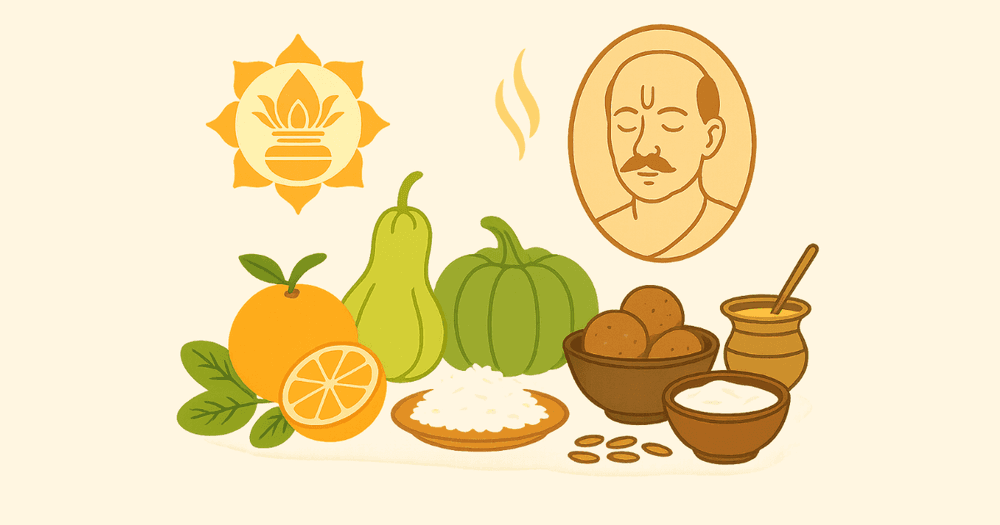Pitru Paksha 2025 Diet: The Complete Sattvic Food Guide - Exactly What to Eat, What to Avoid and the Scientific Rationale of Ritual Purity
By Pt. Sanjeev Sharma
Food, Shraddha, Ritual Offering and Health: The Blend of Purity and Nutritional Insight

Table of Contents
Pitru Paksha, also known as the fortnight of shraddha, is a period in Indian tradition dedicated to remembrance, respect and gratitude towards ancestors. In 2025, Pitru Paksha will be observed from September 7 to September 21. During these sixteen days, the ancestors are believed to visit the earth and their descendants perform rituals like shraddha, tarpan, pind dan and various acts of devotion to please them. In the depth of these traditions and scriptures, diet becomes crucial for cleansing both body and mind and for creating a positive sacred atmosphere.
What Is Pitru Paksha and Why Is Food So Religious and Significant During This Period?
According to classical belief, every grain and morsel consumed or offered during Pitru Paksha directly affects not just the devotee or the family but also the spiritual progress of the departed ancestors. therefore sattvic and pure food is not only prepared but also consumed and donated with great care. Such food supports digestion, meditation, remembrance and satisfaction.
Key Dates and Their Importance During Pitru Paksha
| Date | Importance | Ritual Focus |
|---|---|---|
| 7 September | Pitru Paksha begins | First shraddha, tarpan |
| 21 September | Pitru Paksha ends, Amavasya | Sarvapitri shraddha, special rituals |
Why Is Sattvic Diet Essential? Modern Science and Ancient Wisdom
Sattvic food is a supporter of physical energy, smooth digestion, mental steadiness and disciplined living. Modern science agrees that excessive spicy, oily, old or non-vegetarian food can disrupt calmness and induce lethargy. Scriptures say, "As is the food, so is the mind."
| Sattvic Food Component | Nutritional and Psychological Benefit |
|---|---|
| Fresh fruits | Vitamins, minerals, hydration, revitalizes |
| Milk, curd, ghee | Calcium, protein, emotional steadiness |
| Whole grains | Fiber, sustaining energy, balance |
| Sesame and jaggery | Digestion, sacredness, inspiration |
| Light green vegetables | Cooling, easy digestion, natural purity |
What Foods Must Be Avoided? Rationale for Tradition and Health
Specific food items are strictly avoided so that discipline, sanctity and meditative serenity prevail.
| Forbidden Foods | Religious Reason | Health/Science Perspective |
|---|---|---|
| Meat, fish, eggs | Tamasic, disrespectful to ancestors | Heaviness, impure digestion |
| Alcohol, tobacco, drugs | Disrupts mental discipline | Adverse long-term health impacts |
| Onion, garlic | Rajasic, increase restlessness | Gas, indigestion, emotional upset |
| Stale or old food | Negative energy, dishonoring ancestors | Bacterial risk, toxicity |
| Excess spicy/fried items | Lowers alertness and discipline | Risks obesity, dullness, laziness |
These restrictions serve both spiritual focus and support healthy contemporary lifestyles.
What Should You Definitely Eat During Pitru Paksha? A Comprehensive Guide
A fresh, sattvic and digestible diet is best. The food that contains the subtle qualities of earth, water, fire, air and ether is considered most nourishing and pure.
| Item | Why Is It Essential in the Diet | Scriptural Usage |
|---|---|---|
| Rice, wheat, barley, millets | Energy, calmness, satiety | Vital in pind dan, shraddha |
| Milk, curd, ghee | Purity, sattvic upliftment | Used for tarpan, offering, prasad |
| Selected fruits and flowers | Freshness, vitamins, sanctity | For fruit-offering, prasad, donation |
| Sesame, jaggery, moong dal | Sacredness, nourishment, smoothness | Pind, tarpan, homa (fire-offering) |
| Bottle gourd, ridge gourd, pumpkin, spinach | Easy digestion, inner coolness | Vegetables, for prasad |
When and How to Prepare, Serve and Distribute Food in Shraddha Rituals
- Always prepare food fresh for the day; do not reheat or reuse.
- Use the purest space in the home for preparing prasad.
- Offer the first portions to crows, dogs, cows, Brahmins and ancestors, then serve the family.
- Giving food to the hungry and teaching children the meaning of shraddha with sattvic food is most auspicious.
Hidden Psychological Message in Food Traditions
The entire cycle fosters self-control, remembrance, service, discipline and humility. The practice of sattvic food is known to reduce stress, anxiety, imbalance and emotional depression.
Wisdom of Scholars, Triumph of Science and the Deeper Meaning of Rituals
Both modern science and traditional wisdom affirm that sattvic, pure, disciplined food is a boon for health, mind and community. The sacred tradition of Pitru Paksha deeply binds every Indian home to wellbeing, peace, discipline and virtues.
Five Essential Questions (FAQs) and Their Answers
1. Is fasting compulsory during Pitru Paksha? What is the ideal way to observe it?
Many keep a fruit or water fast or practice light sattvic eating and abstinence from non-sattvic foods.
2. Are the same diet rules for children and elders?
Yes, soft, pure, easily digestible sattvic meals benefit everyone. Those who are ill or pregnant may have fruits, milk or mildly spiced dishes.
3. Should the prasad of shraddha be shared among family members?
Certainly. But it must first be offered to the ancestors, animals and Brahmins.
4. Is it especially auspicious to eat from copper or earthen vessels?
Yes, copper, bronze and earthen pots are traditionally blessed for use in shraddha meals.
5. Which foods are considered most sacred in Pitru Paksha?
Rice, milk, sesame, ghee, jaggery and fruits are considered top offerings in all ancestor rituals.
Get your accurate Kundali
Generate KundaliDid you like it?
Author

Pt. Sanjeev Sharma (50)
Experience: 15
Consults About: Family Matters, Spirituality
Clients In: DL, MH, UP
Share this article with friends and family